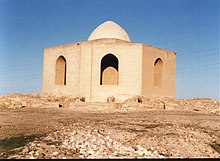
Back قبة (عمارة إسلامية) Arabic কুব্বা Bengali/Bangla Qubba Catalan Qubba German Qubba Spanish Qoubba French Qubba NB Kubba Polish Cuba (islamismo) Portuguese

A qubba (Arabic: قُبَّة, romanized: qubba(t), pl. قُباب qubāb),[3] also transliterated as ḳubba, kubbet and koubba, is a cupola or domed structure, typically a tomb or shrine in Islamic architecture.[1][2][4][5] In many regions, such as North Africa, the term qubba is applied commonly for the tomb of a local wali (local Muslim saint or marabout), and usually consists of a chamber covered by a dome or pyramidal cupola.[6][7][1]
- ^ a b c Petersen, Andrew (1996). Dictionary of Islamic architecture. Routledge. p. 240. ISBN 978-1134613663.
- ^ a b M. Bloom, Jonathan; S. Blair, Sheila, eds. (2009). "Tomb". The Grove Encyclopedia of Islamic Art and Architecture. Oxford University Press. p. 342. ISBN 978-0195309911.
- ^ Tabbaa, Yasser (2017). "Dome". In Fleet, Kate; Krämer, Gudrun; Matringe, Denis; Nawas, John; Rowson, Everett (eds.). Encyclopaedia of Islam, Three. Brill. ISBN 978-9004161658.
- ^ Ettinghausen, Richard; Grabar, Oleg; Jenkins-Madina, Marilyn (2001). Islamic Art and Architecture: 650–1250 (2nd ed.). Yale University Press. p. 338. ISBN 978-0300088670.
- ^ Petersen (2001), p. 326.
- ^ Binous, Jamila; Baklouti, Naceur; Ben Tanfous, Aziza; Bouteraa, Kadri; Rammah, Mourad; Zouari, Ali (2010). Ifriqiya: Thirteen Centuries of Art and Architecture in Tunisia. Islamic Art in the Mediterranean. Museum With No Frontiers & Ministry of Culture, the National Institute of Heritage, Tunis.
- ^ Touri, Abdelaziz; Benaboud, Mhammad; Boujibar El-Khatib, Naïma; Lakhdar, Kamal; Mezzine, Mohamed (2010). Andalusian Morocco: A Discovery in Living Art (2 ed.). Ministère des Affaires Culturelles du Royaume du Maroc & Museum With No Frontiers. ISBN 978-3902782311.